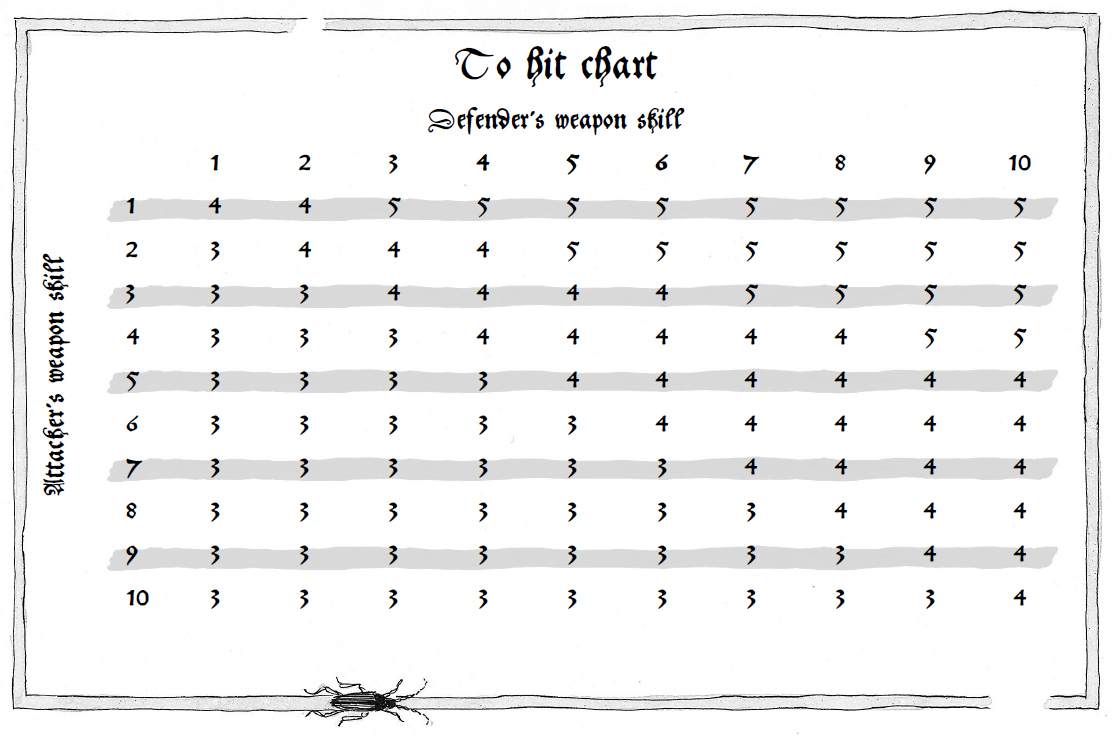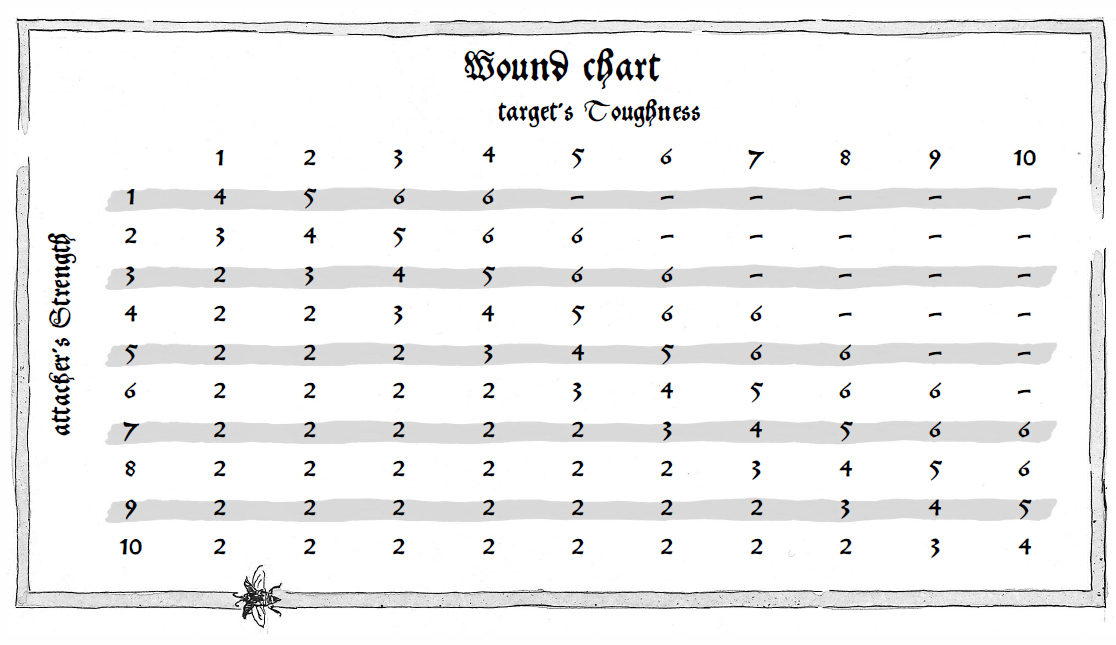Close Combat
who can fight
Models whose bases are touching are engaged in hand-to-hand combat. This can only happen once a warrior has charged his enemy, as models are otherwise not allowed to move into contact.
All close quarter fighting is worked out in the hand-to-hand combat phase. Regardless of whose turn it is, all models in hand-to-hand combat will fight. A warrior can fight against enemies to his side, front, or rear. In reality the fighters are constantly moving, dodging, and weaving as they struggle to kill their adversaries.
Models fighting in hand-to-hand combat do not shoot in the shooting phase. They are far too busy fighting for their lives. Any very close range shots they are able to make using pistols are treated like close combat weapon attacks (see the Weapons & Armour section).
who strikes first
Normally, models fight in order of descending Initiative with the highest striking first. If their Initiatives are equal, roll a dice to see who strikes first.
If a model stood up in the Recovery phase of that turn, then he will strike last irrespective of any other circumstances.
Sometimes a model will be allowed to ‘strike first’ for some reason. Most commonly this is because they charged in that turn, but some equipment, skills and spells produce the same effect. If only one model ‘strikes first’ then it does so and the remainder of the combatants strike in Initiative order as described above.
If there are several models who are each entitled to ‘strike first’, then they determine the order of combat between themselves by Initiative, as described above. Once all those that were eligible to ‘strike first’ have fought, any other combatants fight in Initiative order.
which models fight
A model can fight if its base is touching the base of an enemy model. Even models attacked from the side or rear can fight.
If a warrior is touching more than one enemy, he can choose which to attack. If he has more than 1 Attack, he can divide them in any way the player wishes, so long as he makes this clear before rolling to hit.
hitting the enemy
To determine whether hits are scored, roll a D6 for each model fighting. If a model has more than 1 Attack roll a D6 for each attack.
The dice roll needed to score a hit on your enemy depends upon the Weapon Skills of the attacker and the foe. Compare the Weapon Skill of the attacker with that of his opponent and consult the To Hit chart below to find the minimum D6 score needed to hit.
Hit Roll

fighting with two weapons
Some maniac warriors carry two weapons, one in each hand, so they can rain a flurry of blows on their enemies. A warrior armed with two one-handed weapons may make 1 extra Attack with the additional weapon. Note that this is added to the total of the warrior’s attacks after other modifiers, such as frenzy, have been applied. If he is armed with two different weapons (sword and dagger, for example), he will make a single attack with whichever weapon he chooses, and all others with the remaining weapon. Roll to hit and wound for each weapon separately.
weapon modifiers
Unlike hits from shooting, the Strength of the attacker is used to determine wounds, rather than that of the weapon itself. However, some weapons confer a bonus on the attacker’s Strength (see the Weapons & Armour section for full details).
roll to wound
Once your model has hit a target you must test to see whether a wound is inflicted. Sometimes a strike may fail to wound simply because it causes an insignificant injury or glances off the enemy’s equipment.
To determine whether the blow has caused a wound compare the Strength of the weapon with the Toughness of the target. You will find a complete description of the various weapons together with their Strength values and special rules in the Weapons & Armour section.
Follow the same procedure for wounding and causing critical hits as in the Shooting section. Note that a dash (–) means that there is no chance of wounding the target.
Wound Roll

armour
Combatants that are wounded have the chance to avoid damage if they are wearing armour or carrying shields. This is exactly the same as described for shooting, and the same rules apply.
For each wound suffered the player rolls a D6. If he rolls greater than or equal to the armour save of his fighter then that wound has been absorbed or deflected by the armour.
armour save modifiers
Some models are so powerful that armour provides less protection against them.
The higher a creature’s Strength the more easily it can pierce armour. The following chart shows the reduction in the enemy’s armour saving throw caused by the attacker’s Strength.
| Strength | Save modifier |
|---|---|
| 1-3 | None |
| 4 | -1 |
| 5 | -2 |
| 6 | -3 |
| 7 | -4 |
| 8 | -5 |
| 9+ | -6 |
Some weapons also confer a bonus to the user’s Strength, making it more likely that any hits will pierce the opponent’s armour. These bonuses are given in the Weapons & Armour section.
parry
Bucklers are small shields which offer no increase to the armour saving throw, but allow you to parry attacks. Swords are also used to parry enemy attacks.
When an opponent scores a hit, warriors equipped with bucklers or swords may try to parry the blow.
Roll a D6. If the score is higher than the number your opponent rolled to hit, the buckler or sword has parried the strike. Note that it is therefore impossible to parry a blow which scored a 6 on the roll to hit.
A buckler or sword may only parry one blow per hand-to-hand combat phase. A parried blow is ignored and has no effect. If your opponent scored several hits, you will have to try to beat the highest score (if the highest score is a 6, you automatically lose the chance of parrying that opponent’s attacks). If a model is fighting against several opponents, it may only parry the strike from the enemy who makes the first hit(s) (ie, the attacking model with the highest Initiative). In the case of equal Initiative characteristics roll a dice to decide who strikes first.
If your model is armed with a buckler and a sword, you may re-roll any failed parries once. A model armed with two swords can still only roll once.
A model may not parry attacks made with twice (or more) his own basic Strength – they are simply too powerful to be stopped.
warriors knocked down
If an enemy is fighting a warrior who is knocked down, he may attack him to put him out of his misery. All attacks against a warrior who is knocked down hit automatically. If any of the attacks wound the knocked down model and he fails his armour save, he is automatically taken out of action as explained previously. A knocked down model may not parry.
warriors stunned
A stunned warrior is at the mercy of his enemies. A stunned model is automatically taken out of action if an enemy can attack him in hand-to-hand combat.
attacking stunned and knocked down warriors
Note that a model with multiple attacks may not stun/knock down and then automatically take a warrior out of action during the same hand-to-hand combat phase. The only way you can achieve this is to have more than one of your models attacking the same enemy. So, if the enemy is stunned/knocked down by the first warrior, he can be hit and put out of action by the next warrior to attack.
If your model is engaged in close combat with an enemy who is still standing, he cannot attack any other models that are stunned or knocked down, since in reality they will not pose an immediate threat to him and their companions will try to protect them.
moving from combat
Once models are engaged in hand-to-hand combat they cannot move away during their movement phase. They must fight until they are either taken out of action, until they take out their enemies, or until one or the other breaks and runs.
The exception to this rule is that if all a model’s close combat opponents are knocked down or stunned, he may move away from the combat if you wish, and even charge other enemies within range.
breaking from combat
A warrior who panics whilst fighting in hand-to-hand combat will break off and make a run for it as described in the Leadership & Psychology section.
When a fighter breaks from combat he simply turns and runs off. His opponents automatically hit the warrior as he breaks, each inflicting 1 hit which is worked out immediately.
Note that warriors cannot choose to leave a fight voluntarily.